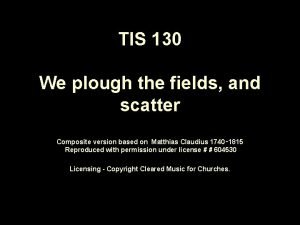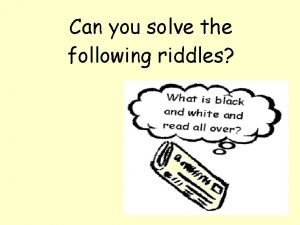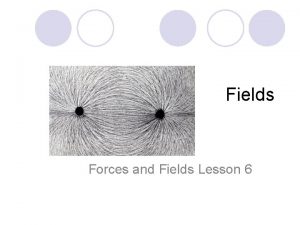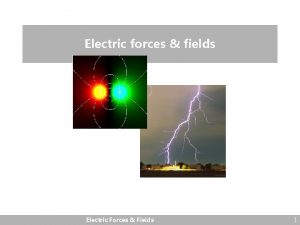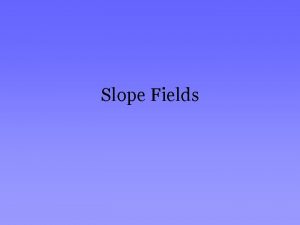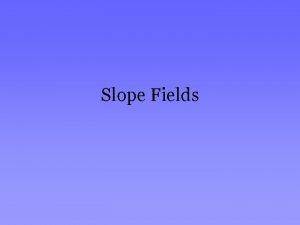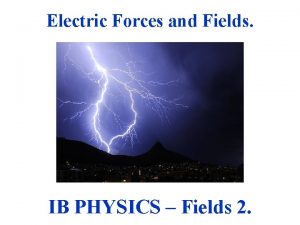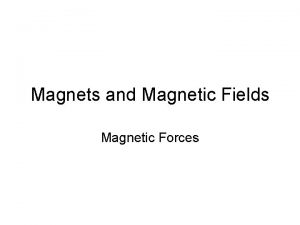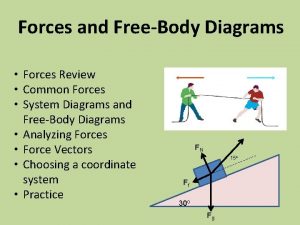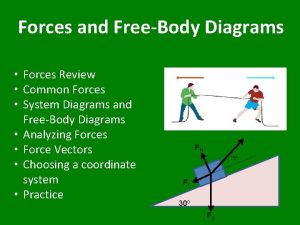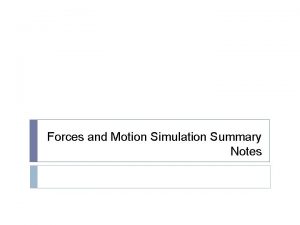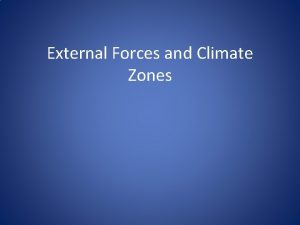Forces and Fields Module 4 Forces and Fields


























- Slides: 26

Forces and Fields Module 4

Forces and Fields • There are four fundamental types of force and field: Force Approximate Relative Strength Range (m) Strong Nuclear 1038 10 -15

Forces and Fields • There are four fundamental types of force and field: Force Approximate Relative Strength Range Strong Nuclear Electromagnetic 1038 1036 10 -15 Infinite

Forces and Fields • There are four fundamental types of force and field: Force Approximate Relative Strength Range Strong Nuclear Electromagnetic Weak 1038 1036 102 10 -15 Infinite 10 -18

Forces and Fields • There are four fundamental types of force and field: Force Approximate Relative Strength Range Strong Nuclear Electromagnetic Weak Gravitational 1038 1036 102 1 10 -15 Infinite 10 -18 infinite We shall look at all these forces except the weak. Although they have been unified, we shall consider electric and magnetic fields separately.

Gravitational Fields

A Timeline of Gravity • Order the scientists and the progress made in understanding gravity.

Mass • The mass of a body is the amount of. . . . . it contains. Mass is a base quantity measured in. . . . . It is a. . . . . Quantity. It does not depend on weight. Weight • Release a body near the Earth and it. . . . . towards the Earth. This occurs because a. . . is exerted on the body by the Earth. The size of this. . . . . is called the. . . . . of the body. The Earth pulls harder on. . . . . masses. The. . . . . of a body depends on the. . . . . of the body. Close to the surface of the Earth, the Earth pulls on each kilogram of mass with a force of about. . . A body of mass 10 kg therefore feels a force of. . .

Gravitational Force, F • A pair of gravitational forces results from the mutual attraction between any two bodies. • These forces are known as weight (not gravity). • Why are we not aware of the attractive force we exert on the Earth?

Investigating Gravitational Force • Place a lead mass on top of a balance pan and record the reading. • Support a second lead mass from a retort stand. Slowly lower it towards the mass on the balance. • What happens to the reading on the pan balance? • As the two bodies approach, the gravitational attraction ____ causing the reading on the balance to ____. • What would happen if the mass M was increased? pan balance

Newton’s Law of Gravitation • The force of gravity is universal and acts between all bodies. The force that acts on Earth to cause a body to fall also extends across space to hold the Moon in orbit round the Earth. • Force between two masses α product of the two masses separation 2 α m 1 m 2 r 2 inverse = - G m 1 m 2 square law r 2 • G = the universal gravitational constant = 6. 67 x 10 -11 Nm 2 kg-2 • r is the distance from one centre of mass to another. • The minus sign indicates an attractive force. The radial distance r is measured outwards from the attracting body; the force F acts in the opposite direction, and so our sign convention is negative.

Task • Calculate the gravitational attraction between you and your neighbour if you sit with your centres of mass 0. 75 m apart. • How does this force compare with the gravitational force exerted on each of you by the Earth, i. e. your weight? • Newton’s Law of Universal Gravitation strictly applies to uniform spherical bodies. It may then be assumed that their centre of mass is located at their centre. The law may also be applied to other bodies if their separation is large compare with their mass.

Weighing the Earth Bill Bryson - A Short History of Nearly Everything • Newton’s Law of Gravitation stated that everything in the Universe exerts a tug on every other. He said that a plumb line near a mountain would incline very slightly towards the mountain, affected by the gravitational mass of the mountain as well as by the Earth’s. • If you measure the deflection accurately and work out the mass of the mountain…. You could calculate G, and therefore the mass of the Earth. • In the summer of 1774, Maskelyne lived in a tent in a remote Scottish glen and spent his days directing a team of surveyors and mathematicans. They began to plot the mountain and determine the volume. By joining points of equal height, they created contour lines! • The team came up with an answer for the mass of the Earth, however, many were left unsatisfied as the team had assumed that the density of the mountain was constant and equal to that of stone.

• The first accurate measurement of G was made in 1798 by Henry Cavendish (in Clapham) – more than 100 years after Newton proposed the law. • Two small lead masses were attached to a bar and suspended from a long thin wire. Two large lead masses in the positions shown attracted the small masses, causing the bar to rotate slightly against the restoring force from the wire. • Cavendish measured the angle of rotation and from this calculated the force between the masses. He then used the force, the masses and their separation to calculate G. • A year later, Cavendish announced that the Earth weighed 6 billion trillion tonnes. • Today, the best estimate is 5. 97 billion trillion tonnes (difference of 1%).

Weighing the Earth Sphere Mass (kg) Radius (mm) large 168 152 small 6. 22 51 1. 2. 3. 4. Calculate the force of attraction between two masses, each of 1 kg and separated by 10 cm. Why does this suggest that Cavendish chose to use lead spheres? Calculate the greatest gravitational force that Cavendish’s spheres could have exerted on each other. Cavendish’s experiment determined a value for G. Why did he describe his experiment as “weighing the Earth? ”

“Weighing the Earth”. • At the surface of the Earth, a 1 kg mass has a weight of. . . • The gravitational force acting on this mass is. . . • The radius of the Earth is 6400 km so the centres of mass of the two bodies are 6400 km apart. • F = = • ME = - G m 1 ME r 2 - 6. 67 x 10 -11 ME = 9. 81 (6, 400, 000)2 6 x 1024 kg

Exam Questions 1. Write a word equation which states Newton’s law of gravitation. (2) Mars may be assumed to be a spherical planet with the following properties: Mass m. M of Mars Radius r. M of Mars = = 6. 42 × 1023 kg 3. 40 × 106 m Calculate the force exerted on a body of mass 1. 00 kg on the surface of Mars. (3) For any planet the relationship between g (the free fall acceleration at the surface) the planet’s density r and its radius R is g = ρr. GR Has Mars a larger, smaller or similar radius to the Earth? Explain your reasoning. (2) (Total 7 marks)

Exam Questions 1. Write a word equation which states Newton’s law of gravitation. (2) Force proportional to product of masses and inversely proportional to (distance / separation) squared Mars may be assumed to be a spherical planet with the following properties: Mass m. M of Mars Radius r. M of Mars = = 6. 42 × 1023 kg 3. 40 × 106 m Calculate the force exerted on a body of mass 1. 00 kg on the surface of Mars. 3. 7 N (3) For any planet the relationship between g (the free fall acceleration at the surface) the planet’s density r and its radius R is g = ρr. GR Has Mars a larger, smaller or similar radius to the Earth? smaller Explain your reasoning. (2) g is less, but density, r, is similar/same [so R is less] (Total 7 marks)

Exam Questions 2. The diagram shows a body of mass m situated at a point which is a distance R from the centre of the Earth and r from the centre of the Moon. The masses of the Earth and Moon are ME and MM respectively. The gravitational constant is G. Using the symbols given, write down an expression for (i) the gravitational force of attraction between the body and the Earth. (ii) the gravitational force of attraction between the body and the Moon. (2) The resultant gravitational force exerted upon the body at this point is zero. Calculate the distance R of the body from the centre of the Earth given that r = 3. 9 × 107 m and ME = 81 MM (3) (Total 5 marks)

Forces (i) (ii) F = GMEm/R 2 F = GMMm/r 2 Distance R R = 3. 5 × 108 m

Gravitational Fields

Gravitational Field Strength, g • A gravitational field is a region of space around a mass in which any other mass experiences a force. • This is defined as the force per unit mass and is a vector quantity. • g=F/m • m = the mass upon which the force is acting • Near the Earth’s surface g has a value of 9. 81 N kg-1 • A mass in free fall has only its weight (W = mg) acting on it. • From Newton’s Second Law, F = ma • These two expressions may be equated to give; a = g (with same units)

Calculating Field Strength • At the Earth’s surface, the g = 9. 81 Nkg-1. In fact, its value varies from place to place. Local variations in g can give important information about the composition of the Earth in that area. • We have also predicted how g varies with distance from a consideration of field lines round a spherical body. We can verify this prediction using Newton’s law of gravitation. • F = - G m 1 m 2 r 2 • Weight is the gravitational field experienced by a mass in a gravitational field. W = mg • G is the universal gravitational constant – the constant of proportionality in Newton’s law of gravitation. It does not change. • g is the gravitational field strength at a particular point – the force per unit mass. It varies from place to place.

Examples • Taking the mass of the Earth to be 6. 0 x 1024 kg and G to be 6. 7 x 10 -11 Nm 2 kg-1, verify that the gravitational field strength is 0. 0028 Nkg-1 at the distance of the Moon’s orbit, 3. 8 x 108 m from Earth. • g = • Calculate the gravitational field strength due to the Sun at the orbit of the Earth. Take the mass of the Sun to be 2. 0 x 1030 kg and the radius of the Earth’s orbit to be 1. 5 x 1011 m. • g=


Representing Gravitational Fields • The gravitational field of the Earth is radial. The field lines radiate out from the centre. g decreases α 1/r 2. • If only a small region of the field is considered, the field lines become almost parallel and equidistant. The gravitational field is said to be uniform up to a height of about 20 km with a value of 9. 81 N kg-1.
 Learning: module 26: magnetic forces and fields
Learning: module 26: magnetic forces and fields Red fields
Red fields Electric forces and fields concept review
Electric forces and fields concept review Chapter 16: electric forces and fields answers
Chapter 16: electric forces and fields answers C device module module 1
C device module module 1 Definition of parallel forces
Definition of parallel forces Contact vs noncontact forces
Contact vs noncontact forces Balanced forces and unbalanced forces venn diagram
Balanced forces and unbalanced forces venn diagram Constructive forces and destructive forces
Constructive forces and destructive forces The forces shown above are pushing/pulling forces
The forces shown above are pushing/pulling forces Intramolecular forces vs intermolecular forces
Intramolecular forces vs intermolecular forces Difference between intermolecular and intramolecular
Difference between intermolecular and intramolecular Intermolecular force of attraction
Intermolecular force of attraction Plough the fields and scatter
Plough the fields and scatter Rodan and fields tax write offs
Rodan and fields tax write offs Lesson outline lesson 1 magnets and magnetic fields
Lesson outline lesson 1 magnets and magnetic fields Banana dresser grammar potato revive
Banana dresser grammar potato revive Maxwell's equations faraday's law
Maxwell's equations faraday's law Branches of psychology
Branches of psychology Chapter 33 conceptual physics
Chapter 33 conceptual physics Multiplicative inverse
Multiplicative inverse Electric currents and magnetic fields
Electric currents and magnetic fields Visualizing magnetic field
Visualizing magnetic field Norm rule fields
Norm rule fields How many fields in computer science
How many fields in computer science Anterior thorax
Anterior thorax Hirschburg test
Hirschburg test













